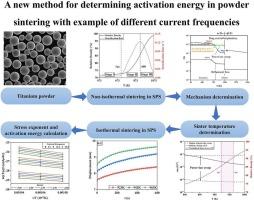A new method for determining activation energy in spark plasma sintering
IF 4.5
2区 工程技术
Q2 ENGINEERING, CHEMICAL
引用次数: 0
Abstract
In general, the power-law creep is used to calculate the activation energy in hot press powder sintering. However, associated difficulty is caused by its large amount of exploratory experiments and multiple creep mechanisms of metal powder with holding time at specific temperatures and macroscopic pressures. In the present study, we propose a new method combining the stress-temperature map of metals and the power-law creep equations, that allows for a faster determination of the creep temperature interval of metals, and finally an accurate determination of the creep mechanism in powder sintering. We verified the viability of this method by varying the pulse current frequency during spark plasma sintering of pure titanium powder. It is also concluded that the higher pulse current frequency is able to reduce the activation energy of pure titanium powder. Accordingly, the results obtained provides a labor-saving method to determine the activation energy of metals in powder sintering.

确定火花等离子烧结活化能的新方法
一般来说,热压粉末烧结中的活化能计算采用幂律蠕变法。然而,由于大量的探索性实验以及金属粉末在特定温度和宏观压力下保持时间的多种蠕变机理,造成了相关的困难。在本研究中,我们提出了一种结合金属应力-温度图和幂律蠕变方程的新方法,可以更快地确定金属的蠕变温度区间,并最终准确确定粉末烧结中的蠕变机制。在纯钛粉末的火花等离子烧结过程中,我们通过改变脉冲电流频率验证了这种方法的可行性。结果表明,脉冲电流频率越高,纯钛粉末的活化能就越低。因此,所获得的结果为确定金属在粉末烧结中的活化能提供了一种省力的方法。
本文章由计算机程序翻译,如有差异,请以英文原文为准。
求助全文
约1分钟内获得全文
求助全文
来源期刊

Powder Technology
工程技术-工程:化工
CiteScore
9.90
自引率
15.40%
发文量
1047
审稿时长
46 days
期刊介绍:
Powder Technology is an International Journal on the Science and Technology of Wet and Dry Particulate Systems. Powder Technology publishes papers on all aspects of the formation of particles and their characterisation and on the study of systems containing particulate solids. No limitation is imposed on the size of the particles, which may range from nanometre scale, as in pigments or aerosols, to that of mined or quarried materials. The following list of topics is not intended to be comprehensive, but rather to indicate typical subjects which fall within the scope of the journal's interests:
Formation and synthesis of particles by precipitation and other methods.
Modification of particles by agglomeration, coating, comminution and attrition.
Characterisation of the size, shape, surface area, pore structure and strength of particles and agglomerates (including the origins and effects of inter particle forces).
Packing, failure, flow and permeability of assemblies of particles.
Particle-particle interactions and suspension rheology.
Handling and processing operations such as slurry flow, fluidization, pneumatic conveying.
Interactions between particles and their environment, including delivery of particulate products to the body.
Applications of particle technology in production of pharmaceuticals, chemicals, foods, pigments, structural, and functional materials and in environmental and energy related matters.
For materials-oriented contributions we are looking for articles revealing the effect of particle/powder characteristics (size, morphology and composition, in that order) on material performance or functionality and, ideally, comparison to any industrial standard.
 求助内容:
求助内容: 应助结果提醒方式:
应助结果提醒方式:


